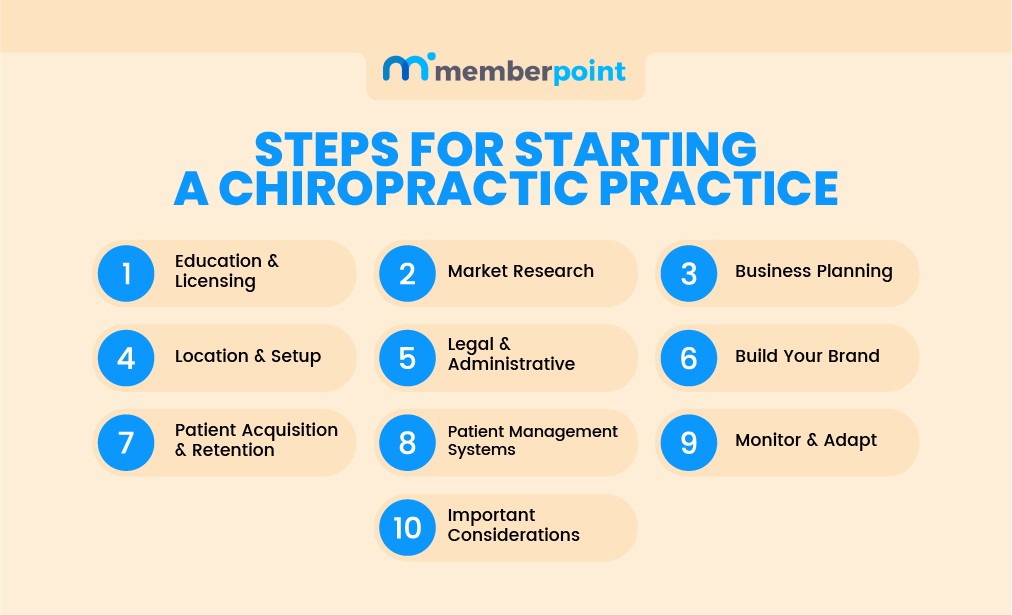

Starting a chiropractic practice can be fascinating and rewarding at times. However, several challenges exist along the way. Many chiropractors embarked on this journey, and business ownership brought about complexity they never imagined.
Every step of acquiring funding and designing the brand, among others, requires cautious planning and strategic thinking.
This blog post will discuss the key steps for starting a chiropractic practice. Whether you are thinking about opening your own practice or have already begun the process, this article will help give you the knowledge you need to move forward confidently.

Chiropractic practice starts with the knowledge and competence required to start a chiropractic practice. Let’s take the main steps you have to make:

This step is the right education and licensing pursuit on your path to becoming a successful chiropractor. This requires dedication and observance toward high standards of academic and professional bodies.
Pro Tip: Take continuing education courses to maintain an active license. By keeping current with new research and techniques, you remain compliant with regulations and give your patients better care.

Now that you have qualified, identifying where and how you would like to set up your business is a question. You must find where the market is going, who you are going after, and how to distinguish them.
Define your ideal patient profile. Look into demographics like age, lifestyle, and what most commonly ails patients in your locality. For example, if you operate in a dominated community, back pain and correct posture treatments might be highly demanded.
Learn about the chiropractors that already exist in your location. Note their service provisions, rates, patient comments, and marketing approaches. Where is it weak? In which niche can you serve? Consider a case in point, such as prenatal or pediatric chiropractic services.
Use online surveys, demographic reports, and Google Trends to understand what potential patients might be searching for and whether your chosen location needs more chiropractic care. Government health data, such as local chamber of commerce reports, can help assess the population’s health needs.
Pro Tip: Organize free health workshops or visit local events to gain first-hand insights into your community’s needs. This will help refine your services and raise awareness for your future practice.

Developing a sound business plan is essential in bringing your chiropractic practice vision to life. This plan will help guide your decisions, ensure funding, and provide the framework for long-term success.
First, calculate your start-up costs. Consider some of the significant expenses:
Specify the chiropractic services you will offer. The services should fall within your areas of expertise and address the needs of your target market. Consider offering bundled treatment for chronic conditions that encourage retention and predictable revenue streams.
Base your prices on an in-depth analysis of the competition, patient pay, and your cost structure. You can charge more if your region has a high demand for services such as prenatal chiropractic care. To attract new visits, you can offer first-time discounts or introductory promotions.
Build your patient base through a multi-channel marketing approach:

A good location and office setup are crucial in making your practice successful. When choosing such, always consider accessibility and patient comfort.
The location must be easily accessible, both in terms of reaching and navigating, with easy access to parking and public transport. Ideally, the office must be located in an area often visited by your target demographic, such as close to business districts for office workers or fitness centers for the sporty type. Make sure that the space meets your requirements:
Determine whether renting or buying works better according to your budget. Renting gives flexibility and is ideal when the business has just started or when testing the market. However, buying can be a long-term stability affair if you buy it to stay in one location for quite some time.
High-quality chiropractic equipment is not an option: ergonomic adjusting tables, therapy, ultrasound machines, or electrical muscle stimulators. Choose from diagnostic tools that guarantee reliability for accurate diagnoses.
An office environment that combines professionalism with comfort may have soothing colors, proper lighting, and well-crafted furniture. In the waiting room, features like a water dispenser, reading material, and background music must make patients feel welcome.
Pro Tip: Place personal touches like framed diplomas or community awards on the walls to boost your patients’ confidence.

Setting up the legal and administrative framework for your chiropractic practice is a step that marks the required compliance on the one hand and, in avoiding liability, the protection of your business from some probable risks.
The business structure is key because it affects taxes, liability, and operational flexibility. The most common types include:
Obtain legal or accounting advice to determine which entity structure best suits your long-term objectives and provides the most defensible protection of your assets.
Insurance is something you can only practice with. First, find malpractice insurance to protect in case of alleged malpractice by your care as a chiropractor. Then, acquire general business liability insurance because you risk damaging property, slipping, and falling in your facility.
Each state has its own set of regulations regarding chiropractic practice. Some of the most common compliance steps include:
Accurate medical billing and coding are essential for the smooth running of finances. Chiropractic practices depend significantly on precise coding to secure prompt reimbursement from insurance providers. Consider investing in billing software or hiring a medical billing specialist to reduce errors and minimize the chances of claim denials.

A strong and recognizable brand builds trust and sets it apart from competitors. It doesn’t just stand for a logo; it is a unified identity to which your patients will respond.

Patient attraction and retention are the lifeblood of practices. A holistic approach ensures continuous patient flow and keeps the attention on existing ones.

Streamlining the administration process is essential for a productive and patient-focused chiropractic practice. Current patient management systems make your everyday tasks easier and increase the value of the patient experience.
The days of dealing with paper files and manual appointment scheduling are gone. Modern software allows you to manage scheduling, billing, and patient records. For instance:
The patient management system improves the overall patient experience by providing conveniences like:

Running a successful chiropractic practice requires constant review and adjustment to meet the changing needs of patients and the market.
Some of the important metrics to monitor for your practice are:
The healthcare landscape is constantly changing, and chiropractic care is no different. To keep your practice competitive, stay ahead of the curve by periodically reviewing your service offerings. For example, if you notice more patients with sports injuries, you could add rehabilitation techniques or equipment.
When it is time to grow, have a strategy:

Critical elements to consider before opening your practice for long-term success.
This typically requires completing a four-year doctorate at a chiropractic school and then getting a Doctor of Chiropractic degree after qualifying for the four parts of the National Board of Chiropractic Examiners exam. Licensure in your state, province, or appropriate jurisdiction would also be required for practice.
Although there are other types of chiropractors, the most advantageous job is that of a chiropractic physician.
There are practices in many cities where the chiropractic owner can earn over $1,000,000 annually. They usually have associated doctors in several locations, which has helped to grow the revenue.
Estimating the monetary worth of a chiropractic practice entails tallying its assets, reviewing historical financial records, comparing area sales data, and calculating earning potential using multiples. Experienced appraisers combine these approaches to arrive at a fair overall value.
Starting a chiropractic practice is an exciting journey, considering the long-term success through careful planning, dedication, and appropriate strategies. So, starting with key areas such as obtaining relevant education and licensure, thorough market research, and more effective patient management will help set up a foundation for the practice.
Then, with the proper preparation and persistence, the right approach will help your chiropractic practice thrive while attaining patients’ better health in tandem with your personal and professional goals. Start small, think big, and always focus on providing the best care to every patient who steps through your doors.


Your all-in-one destination for memberships, subscriptions, and installment plans.
16755 Von Karman Avenue #200, Irvine CA 92606
hello@memberpoint.io